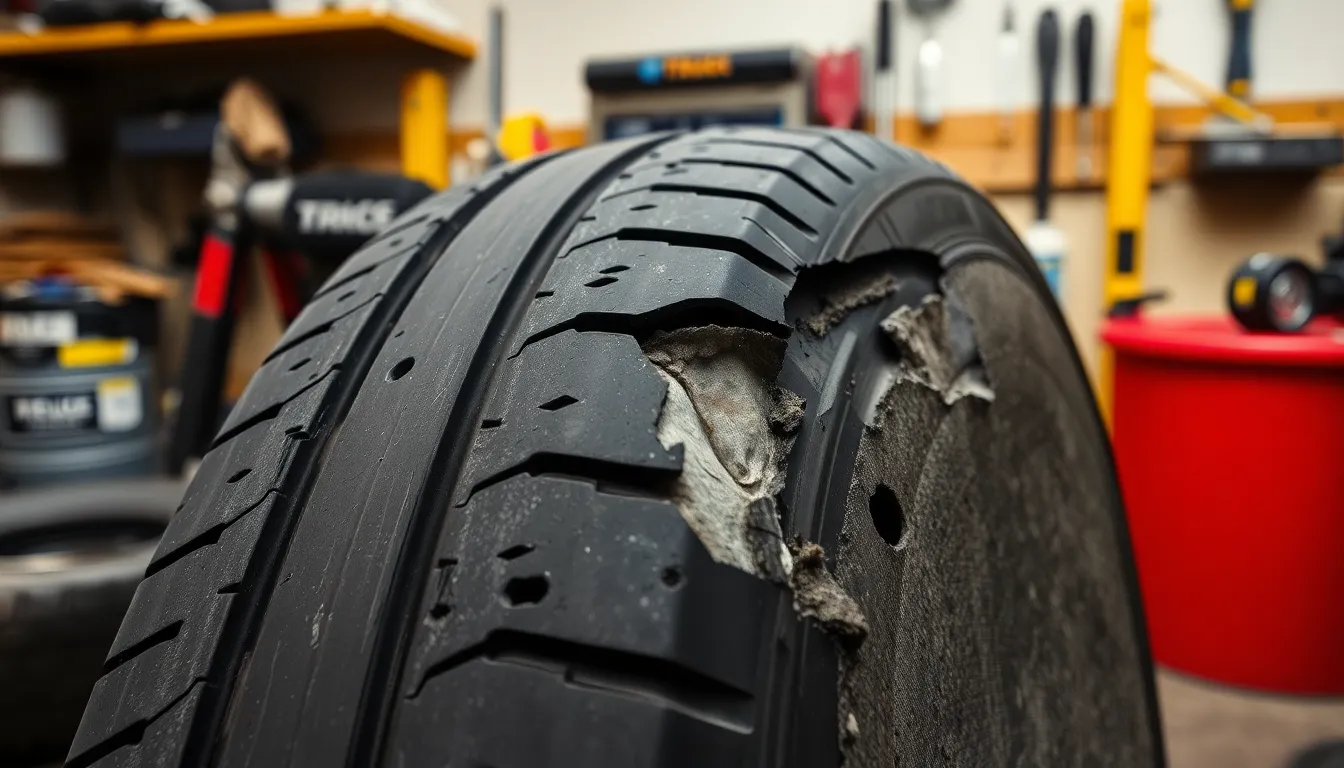We’ve all been there – that sinking feeling when you discover a nail in your tire or hear the dreaded hissing sound of air escaping. Before you panic about expensive tire replacements, there’s good news: tire patching offers an affordable solution that can save you hundreds of dollars.
Understanding tire patch costs isn’t just about knowing the price tag. We’ll explore what factors influence these costs and why professional patching often beats DIY attempts. From budget-friendly options to premium services, the price range varies significantly based on location and tire type.
Most drivers discover that tire patching costs between $10 to $40 – a fraction of new tire prices. We’ll break down everything you need to know about tire patch pricing so you can make informed decisions and get back on the road without very costly.
Average Cost to Get a Tire Patched
Tire patching costs typically range from $10 to $40 at most automotive service centers across the United States. Independent tire shops usually charge between $15 and $25 for a standard patch repair while dealership service departments often price their services between $25 and $40.
Regional variations affect tire patch pricing significantly with urban areas like New York City and San Francisco averaging $30 to $40 per patch compared to rural locations where prices commonly fall between $10 and $20. Chain stores such as Discount Tire and America’s Tire frequently offer patch services for $15 to $25 depending on your location.
| Service Provider Type | Price Range | Average Cost |
|---|---|---|
| Independent tire shops | $15 – $25 | $20 |
| Chain tire retailers | $15 – $25 | $20 |
| Dealership service centers | $25 – $40 | $32 |
| Quick lube stations | $20 – $35 | $27 |
Several factors influence the final cost you’ll pay for tire patching services. Tire size plays a crucial role since larger tires like those on trucks and SUVs often require more labor and materials resulting in charges up to $45. Location within the tire also matters as sidewall damage typically can’t be patched while tread area punctures remain the most affordable to repair.
Premium tire brands may incur additional charges if specialized patches or techniques are required. Run-flat tires cost more to patch due to their complex construction with many shops charging $40 to $60 for these repairs. Emergency or after-hours service calls can double the standard pricing with mobile tire repair services charging $50 to $80 for convenience.
Most tire patches include basic balancing and pressure checks in the quoted price. Additional services like valve stem replacement add $5 to $15 to your total cost while tire rotation services typically cost an extra $20 to $40 when combined with patch repairs.
Factors That Affect Tire Patch Pricing

Several key elements influence how much you’ll pay for tire patch services. Understanding these pricing factors helps you anticipate costs and find the best repair value.
Location and Type of Damage
Damage location significantly impacts repair costs across different tire areas. Patching repairs cost between $10 to $20 for basic damage, making them more cost-effective than plugging methods. Sidewall repairs require specialized techniques that increase prices to $20 or more due to the complex process of dismounting tires and repairing both inner and outer sidewall sections.
Tread area damage typically costs less since technicians can access these spots more easily. Punctures near the shoulder area often fall into a middle price range depending on their exact position and severity.
Tire Size and Vehicle Type
Larger tires demand higher repair costs due to increased material and labor requirements. 33-inch tires typically cost $40 to $55 for complete patching services including labor and materials. Standard passenger vehicle tires generally cost less than truck or SUV tires because of their smaller size and simpler handling requirements.
Commercial vehicle tires often require specialized equipment and expertise, which drives up service costs. Motorcycle tire patches usually cost less than car tire repairs due to their compact size and lighter weight.
Geographic Location and Labor Costs
Regional labor rates create important pricing variations across different areas. Western region shops generally charge higher rates compared to shops in other geographic locations. Hourly labor rates range from $44 to $144, directly impacting your total repair bill.
Urban markets typically command premium pricing due to higher overhead costs and increased demand. Rural areas often offer more competitive rates since operating expenses remain lower than metropolitan locations.
Where to Get Your Tire Patched

Finding the right service provider for tire patching depends on your location, budget, and convenience preferences. Three main options offer professional tire repair services with varying costs and benefits.
Auto Repair Shops
Local and independent auto repair shops provide reliable tire patching services at competitive rates. Most facilities charge between $20 and $50 for standard tire repairs, with labor rates varying based on regional factors and shop overhead costs. Independent shops often offer personalized service and may provide discounts for regular customers or multiple repairs. General automotive service centers typically handle tire patching as part of their broader mechanical services, making them convenient for customers who need additional vehicle maintenance. Many shops can complete simple tire patches within 30 minutes, allowing you to wait while the repair is performed.
Tire Retailers and Chain Stores
National tire retailers like Discount Tire, Firestone, and Goodyear specialize in tire services and often provide the most competitive patching rates. Chain stores frequently offer free tire patches for customers who purchased tires from their locations, while non-customers typically pay between $10 and $20 for repairs. Major retailers stock extensive tire repair materials and employ certified technicians trained specifically in tire maintenance procedures. Regional tire chains may offer loyalty programs that reduce future repair costs or provide package deals combining patching with tire rotation services. Corporate locations maintain consistent pricing standards across multiple states, making costs predictable regardless of which store location you visit.
Mobile Tire Services
Mobile tire repair units bring professional patching services directly to your location, eliminating the need to drive on damaged tires. Service providers typically charge between $20 and $50 for on-site tire repairs, with pricing comparable to traditional shop rates even though the added convenience factor. Mobile services prove especially valuable for roadside emergencies or when you can’t safely reach a repair facility. Response times for mobile tire services usually range from 30 minutes to 2 hours depending on your location and service demand. Many mobile providers operate 24/7 emergency services, though after-hours repairs may include additional fees beyond standard patching costs.
DIY vs Professional Tire Patching

Understanding the difference between DIY and professional tire patching helps you make an well-informed choice about your repair approach. We’ve analyzed both options to provide you with comprehensive cost and safety comparisons.
Cost Comparison
DIY tire repair kits cost between $5 and $25, making them an attractive option for budget-conscious drivers. These kits include patches, glue, and sometimes plugs for immediate repairs. Additional specialized tools range from $15 to $100 depending on your equipment needs.
Professional tire patching services charge between $20 and $50 on average, with specialized repairs reaching $100 or more. Labor and materials are included in these prices, eliminating the need for you to purchase separate tools or supplies.
| Aspect | DIY Tire Repair | Professional Tire Repair |
|---|---|---|
| Cost | $5 to $25 for kit + $15 to $100 tools (if needed) | $20 to $50 average, up to $100+ for specialized repairs |
| Convenience | Immediate if equipped, requires time and effort | Minimal effort; professional assessment and repair |
| Skill Level Needed | Basic mechanical skills required | Handled by trained technicians |
| Repair Quality | Varies by skill; risk of improper repair | Generally higher quality with warranties |
| Warranty | None | Usually offered |
Safety Considerations
DIY repairs carry important risks if not executed correctly, potentially leading to tire damage or safety hazards such as leaks or blowouts. Improperly patched tires may fail on the road, especially when punctures are large, located on the shoulder or sidewall, or when repairs lack proper technique.
Professional repairs offer greater assurance in terms of durability and safety through industry-approved methods. Technicians use plug-patch combinations, which represent the recommended fix for highway use. Professionals can identify when a tire is beyond repair and requires replacement to avoid unsafe conditions.
Repairs on large holes exceeding ¼ inch or tire sidewalls shouldn’t be attempted regardless of method. Tire replacement becomes necessary for safety reasons in these situations, making professional assessment crucial for determining repair viability.
When Tire Patching Isn’t Possible

Tire patching becomes impractical or unsafe in several exact situations that require tire replacement instead of repair. Multiple punctures present the first major limitation, particularly when damages occur less than 16 inches apart or when more than two punctures exist in the same tire. These conditions compromise the tire’s structural integrity beyond what patching can safely restore.
Sidewall damage represents another critical scenario where patching isn’t viable. Repairs to the tire’s sidewall area require complex procedures that often fail to provide the structural soundness necessary for safe driving. Most tire professionals recommend complete tire replacement when sidewall punctures or tears occur.
Tire age and overall condition play crucial roles in determining patch feasibility. Older tires with important wear patterns don’t respond well to patching procedures and may pose safety risks even after professional repair attempts. Worn tread depths below recommended levels make patching ineffective since the tire already requires replacement for safety compliance.
The proximity of punctures creates additional limitations for successful patching. When holes appear within 16 inches of each other, the overlapping stress areas can cause patch failures during normal driving conditions. Professional technicians typically refuse these repairs due to liability concerns and safety standards.
Extensive damage beyond simple punctures eliminates patching as a viable option. Large tears, blowout damage, or cuts exceeding standard repair parameters require immediate tire replacement regardless of the tire’s age or remaining tread life.
Tips to Save Money on Tire Repairs

Comparing prices across multiple local repair shops helps identify the most competitive rates for tire patching services. We recommend obtaining estimates from at least three different providers since costs can vary significantly between shops due to different labor rates and pricing structures.
Purchasing tires from authorized dealers often includes valuable repair benefits that can eliminate patching costs entirely. Many tire retailers offer free puncture repairs for customers who bought their tires from the same location, potentially saving the typical $16.99 to $30 patching fee.
Timing your repair visit strategically can reduce overall expenses when additional services are needed. Combining tire patching with routine maintenance like oil changes or inspections may qualify you for package discounts at many auto service centers.
Exploring mobile tire repair options can provide cost effective answers for emergency situations. Mobile services typically charge between $20 and $50 for patching, eliminating the need for towing fees that can add $75 to $200 to your total repair bill.
Understanding when DIY answers are appropriate helps minimize professional service costs for minor damage. Tire plug kits ranging from $5 to $25 can provide temporary fixes for small punctures, though we recommend professional patching for permanent repairs and safety assurance.
Leveraging warranty coverage reduces out of pocket expenses when applicable damage occurs. Road hazard warranties and tire protection plans often cover patching costs, especially for newer tires with important remaining tread life.
Negotiating repair prices becomes more effective when you understand regional labor rate variations. Shops with $44 hourly labor rates may offer flexibility on pricing, particularly for customers requesting multiple services or demonstrating price comparison research.
Building relationships with local independent shops often results in better pricing for repeat customers. Independent tire shops frequently provide more personalized service and competitive rates compared to chain retailers, especially for standard patching services.
Conclusion
Getting your tire patched doesn’t have to expensive. With costs typically ranging from $10 to $40 we’ve shown that professional tire patching offers excellent value compared to costly tire replacements.
We recommend shopping around for the best rates and considering your exact situation when choosing between DIY and professional services. Remember that safety should always be your top priority – some damage simply requires professional expertise or complete tire replacement.
By understanding pricing factors and knowing where to find quality service you can make informed decisions that keep both your vehicle and wallet in good shape. Take advantage of warranties free repair programs and local shop relationships to maximize your savings on future tire maintenance.
Frequently Asked Questions
How much does it cost to patch a tire?
The typical cost for tire patching ranges from $10 to $40, depending on the service provider and location. Independent tire shops and chain retailers usually charge $15-$25, while dealership service centers may charge $25-$40. This is significantly more affordable than purchasing new tires, making patching an excellent cost-effective solution for minor tire damage.
Where can I get my tire patched?
You can get your tire patched at three main locations: auto repair shops ($20-$50), tire retailers and chain stores (often offering competitive rates), and mobile tire services ($20-$50). National tire retailers frequently provide free patches for customers who purchased tires from them, while mobile services offer convenient roadside assistance.
What factors affect tire patch pricing?
Several factors influence tire patch costs including tire size, damage location, geographic area, and additional services needed. Basic damage costs $10-$20, while sidewall repairs can exceed $20. Larger tires (like 33-inch) may cost $40-$55. Urban areas typically charge more than rural locations due to higher overhead and labor costs.
Should I patch my tire myself or use professional services?
Professional tire patching is generally recommended over DIY repairs. While DIY kits cost $5-$25, professional services ($20-$50) offer trained expertise, proper tools, and warranties. Professional repairs ensure safety and durability, especially for complex damage. DIY should only be considered for minor punctures and temporary fixes.
When should I replace my tire instead of patching it?
Tire replacement is necessary when you have multiple punctures (especially less than 16 inches apart), sidewall damage, extensive tears or blowouts, or when the tire is old with significant wear. These conditions compromise structural integrity beyond safe repair limits, making replacement the only viable option for safety.
How can I save money on tire repairs?
To save money, compare prices from at least three local repair shops, consider purchasing tires from dealers offering free repair benefits, and time visits strategically for package discounts. Mobile repair services can be cost-effective for emergencies, and building relationships with local independent shops often results in better pricing for repeat customers.











